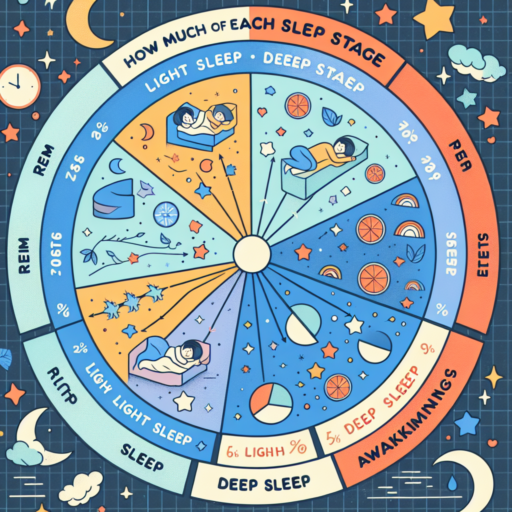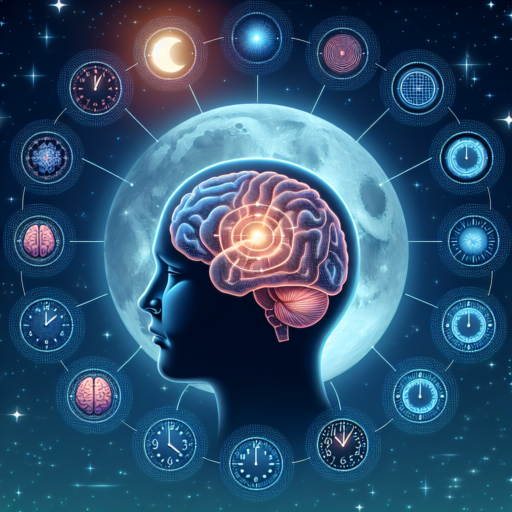Understanding the Importance of Sleep Stages
Sleep is not just a passive activity; it is a complex process that involves several stages, each serving different purposes for our brain and body. Understanding the dynamics of these stages can empower individuals to optimize their sleep for better health and well-being.
The Role of Non-REM and REM Sleep
Non-Rapid Eye Movement (Non-REM) and Rapid Eye Movement (REM) sleep constitute the two main types of sleep stages. Each plays a critical role in our sleep cycle. Non-REM sleep, which is further divided into three stages, forms the bulk of our sleep and is essential for physical restoration, memory consolidation, and hormonal regulation. Meanwhile, REM sleep, known for its association with vivid dreams, is crucial for brain functions, including learning and memory. Paying attention to the balance between Non-REM and REM sleep is essential for holistic well-being.
Understanding Sleep Cycles
A typical sleep cycle lasts about 90 minutes and cycles through Non-REM and REM stages. Most people experience four to six sleep cycles per night. This cyclical pattern of sleep stages plays a vital role in ensuring that we get the restorative benefits of sleep. Misalignment of these cycles, such as through disrupted sleep or irregular sleep patterns, can significantly impact our physical and mental health. Therefore, understanding and respecting the natural progression of sleep stages can lead to improved sleep quality.
Breaking Down the Sleep Cycle: From Light to REM Sleep
Understanding the intricacies of our sleep cycle is key to improving overall health and wellness. From the moment we close our eyes to the point we wake up, our brain navigates through various stages of sleep, each playing a crucial role in rest and recovery. These stages include light sleep, deep sleep, and REM (Rapid Eye Movement) sleep, forming a cycle that repeats several times throughout the night. Let’s delve into these stages to uncover the secrets of a restful night’s sleep.
Light Sleep: The Gateway to Deeper Rest
Our journey into the night begins with light sleep, acting as the bridge between wakefulness and sleep. During this phase, heart rate begins to slow down, muscles relax, and the body starts to disengage from the surroundings. Light sleep is crucial for easy awakening and serves as the foundation for deeper sleep stages. It’s in this stage that the body prepares itself for the regeneration process, making light sleep an indispensable part of the cycle.
Transitioning to Deep Sleep
As we drift further, the body enters deep sleep, a phase where restoration and healing occur. Heart rate and breathing slow to their lowest points, and the brain begins to produce slow waves. This stage is essential for physical recovery, consolidating memories, and boosting the immune system. Deep sleep recharges the body, making it feel refreshed and alert upon waking. It is also the hardest stage from which to be awakened, illustrating the depth of unconsciousness achieved.
The Final Stage: REM Sleep
REM sleep, or Rapid Eye Movement sleep, marks the final phase of the sleep cycle. It is during this stage that most dreaming occurs, with the brain becoming more active. Interestingly, although the brain’s activity mirrors wakefulness, the body remains in a state of paralysis— a phenomenon designed to prevent us from acting out our dreams. REM sleep is critical for emotional regulation, memory consolidation, and creativity. Each cycle of REM becomes longer towards the morning, playing a key role in cognitive functions and overall mental health.
How Much Deep Sleep Do You Really Need?
Understanding how much deep sleep you need is crucial to optimizing your overall health and well-being. Deep sleep, or slow-wave sleep, plays a pivotal role in memory consolidation, physical recovery, and hormone regulation. Most adults require between 1.5 to 1.8 hours of deep sleep per night, which amounts to approximately 20-25% of their total sleep.
Determining the exact amount of deep sleep you need can vary from person to person. Factors such as age, lifestyle, and overall health can significantly impact your individual requirements. For instance, children and teenagers often need more deep sleep to support their developmental processes. However, as we age, the structure of our sleep changes, and we might spend less time in deep sleep phases.
Identifying Your Deep Sleep Needs
- Monitor your sleep with a smart device or wearable that tracks sleep stages.
- Pay attention to how you feel upon waking. Feeling rested and rejuvenated is a good indicator that you’re getting enough deep sleep.
- Consider factors such as stress levels, physical activity, and overall health, which can influence your sleep quality and needs.
The Role of REM Sleep in Your Nightly Rest
Understanding the role of REM (Rapid Eye Movement) sleep is essential for grasping the complexities of our nightly rest. This stage of sleep is not only fascinating but pivotal in ensuring that the mind and body are rejuvenated each night. During REM sleep, our brain activity elevates, resembling the activity levels while we are awake. This uptick in brain function is crucial for several restorative processes that affect our mental and physical health.
The unique aspect of REM sleep is its profound effect on memory consolidation and emotional regulation. Studies have shown that during REM sleep, the brain effectively processes and integrates new information acquired during the day. This nightly mental organization aids in solidified learning and memory formation. Furthermore, REM sleep plays a critical role in emotional health, as it’s during this phase that the brain processes emotional experiences, helping to reduce anxiety and stress levels.
Beyond cognitive benefits, REM sleep also has a significant impact on physical well-being. The increased brain activity during REM phases promotes the release of certain neurotransmitters that are essential for nerve function and immune system regulation. This nightly rejuvenation helps safeguard our health, bolstering our resilience against diseases and maintaining overall bodily function.
Light Sleep: Its Function and Significance
Understanding light sleep is crucial in the broader context of sleep cycles and their impact on our health. Unlike deep sleep stages, light sleep occupies a significant portion of our nightly rest, acting as a transition phase and playing a pivotal role in cognitive functions and overall health. This phase, also known as NREM Stage 2 sleep, is when the body starts to prepare for deep sleep, but the individual can still be easily awakened.
One of the key functions of light sleep includes memory consolidation and information processing. During this stage, the brain sorts and stores the day’s experiences, making sense of new information and transferring it into long-term memory. This process is critical for learning and memory retrieval, highlighting the significance of light sleep in cognitive health and development. Furthermore, this sleep stage helps in the regeneration of cells, repair of tissues, and strengthening of the immune system, underscoring its importance in physical health as well.
Beyond its role in memory and physical health, light sleep also contributes to emotional and psychological well-being. It provides a gentle rest that helps to ease the transition between wakefulness and deeper sleep stages. By facilitating this transition, light sleep helps to ensure that the sleep cycle progresses smoothly, enabling deeper, more restorative sleep stages that are essential for emotional regulation and stress management. Consequently, maintaining adequate light sleep can improve overall mood and resilience against stress.
Optimal Sleep Patterns: How to Achieve the Perfect Balance
Achieving the perfect balance in your sleep patterns is crucial for your overall health and well-being. Understanding the role of circadian rhythms in regulating your sleep-wake cycle is the first step toward optimizing your rest. These natural processes influence your body, behavior, and hormones, guiding you to sleep at night and stay awake during the day. Adapting your lifestyle to support your circadian rhythm can lead to a more restorative night’s sleep.
Key Factors Influencing Sleep Quality
Several factors play an indispensable role in shaping your sleep quality. These include environmental conditions such as light exposure and noise levels, lifestyle habits like caffeine consumption and screen time before bed, and psychological stressors. To achieve optimal sleep patterns, it’s essential to create a conducive sleep environment and a relaxing pre-sleep routine. Minimizing exposure to blue light from screens, reducing noise pollution, and avoiding caffeine late in the day can significantly improve your sleep quality.
Adapting Your Lifestyle for Better Sleep
- Establish a consistent sleep schedule by going to bed and waking up at the same times every day, even on weekends.
- Engage in regular physical activity, but avoid vigorous exercises close to bedtime.
- Create a pre-sleep routine that signals your body it’s time to wind down, such as reading or taking a warm bath.
- Ensure your bedroom environment is optimized for sleep—consider factors like temperature, comfort, and darkness.
Identifying and integrating these practices into your daily life can dramatically enhance your sleep patterns. Remember, small, consistent changes can lead to significant improvements in achieving the perfect balance in your sleep schedule.
How Age Affects the Amount of Each Sleep Stage
Understanding how age influences the different stages of sleep is crucial in comprehending our evolving sleep needs throughout life. As we travel through the journey of life, from infancy to old age, the composition of our sleep undergoes significant changes. These shifts can have a profound impact on health, mood, and cognitive functions.
Children and adolescents, who are in the crucial stages of growth and development, experience longer durations of deep sleep (also known as slow-wave sleep). This stage is pivotal for memory consolidation, cellular repair, and growth hormone release. In contrast, as adults age, there is a noticeable reduction in the amount of deep sleep they achieve each night. This decrease can lead to increased feelings of fatigue and can impact overall well-being.
Furthermore, older adults often see an increase in the lighter stages of sleep and a more fragmented sleep pattern. This fragmentation can result in more frequent awakenings during the night. A key factor in these changes is the natural alteration in the body’s production of sleep-regulating hormones such as melatonin. With advancing age, the timing of these hormone releases shifts, influencing both the duration and quality of sleep.
Common Disruptions in Sleep Stages and How to Mitigate Them
Understanding Sleep Cycle Disruptions
Sleep is a complex process involving various stages, from light to deep sleep and REM (Rapid Eye Movement) sleep. Disruptions in any of these stages can lead to feeling unrefreshed upon waking. Factors such as stress, poor sleeping habits, and health issues are common culprits behind these disruptions. Recognizing the signs of disrupted sleep, including difficulty falling asleep, frequent awakenings, and tiredness during the day, is crucial.
Strategies to Enhance Sleep Quality
Improving sleep quality involves both adjusting your environment and habits. Creating a relaxing bedtime routine and keeping a consistent sleep schedule can significantly help. Additionally, optimizing your bedroom environment—ensuring it is dark, quiet, and at a comfortable temperature—is essential. For many, reducing blue light exposure from screens before bed also makes a substantial difference in falling asleep more easily.
When to Seek Professional Help
While many sleep disruptions can be addressed with lifestyle adjustments, ongoing issues may require professional advice. Conditions such as sleep apnea, insomnia, and restless leg syndrome often need medical intervention for improvement. If sleep problems persist despite making the recommended changes, it is advisable to consult a healthcare provider to explore underlying causes and find a tailored solution.
Using Sleep Trackers to Understand Your Sleep Phases
Exploring the intricate nature of our sleep phases can be a pivotal step towards achieving better sleep health. With the advent of technology, sleep trackers have become an invaluable tool for those looking to enhance their understanding of their sleep patterns. These devices meticulously monitor your sleep, providing insights into the various stages you go through each night, including light sleep, deep sleep, and REM sleep. By analyzing this data, individuals can tailor their sleep habits to improve quality and duration.
Sleep trackers range from wearable devices to bedside monitors, each employing a series of sensors to collect data on your movement, heart rate, and even your breathing rate throughout the night. This information is then analyzed to offer a detailed look at how you cycle through the different phases of sleep. It’s this granular detail that can illuminate potential issues or habits that may be impacting your rest, such as periods of wakefulness or restlessness that you might not be consciously aware of.
Moreover, understanding your sleep phases through these trackers can also aid in identifying trends over time. For example, you might find that your deep sleep phase is most pronounced when you adhere to a consistent bedtime, or that your REM sleep benefits from avoiding caffeine before bed. With this level of insight, adjusting your pre-sleep routine or your environment can lead to profound improvements in sleep quality. This approach promotes a more personalized strategy to sleep management, moving beyond generic advice to find what truly works for your unique pattern.









